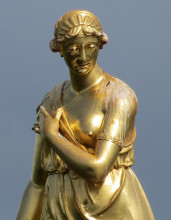
Just across the bridge from Kingston upon Thames in south-west London is Bushy Park, and towards the western side of this large park, near Hampton Court, is the Diana Fountain, with a group of 17th Century statues of which the principal figure, at the summit, is thought to be of the Goddess Diana herself.
The statue of Diana is over life-size, and gilded. She is standing, one foot raised at the heel, her upper body twisted a little to one side, her head the other way in a pose of some elegance, as can be appreciated from the series of pictures a little way down this page. She is lightly dressed, in a short tunic tied well above the waist, and looped over one shoulder leaving her other breast bare. Below, she wears a longer skirt of Classical baroque drapery that hangs back from her forward leg, and swirls with her movement a little above the ankles. On one arm she wears a decorated bracelet, and in her hair she wears a crescent-shaped headpiece and a narrower headband on the forehead.
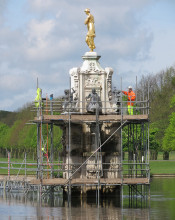 The Diana Fountain, Bushy Park.
The Diana Fountain, Bushy Park.
As is common for an ideal female figure of the 17th Century, Diana’s physique is nicely rounded, smaller in the shoulder and wider at the hip, giving a sense of mass and solidity. Her neck is large and columnar, there is a subtle roundness and muscularity to the shoulder and arms, and rather minimal modelling to the ankles and lower legs. Her eyes are heavily lidded and she has a Renaissance mouth rather than something more Classical. Her hair is curled somewhat, and drawn up away from the neck and tied in a bun at the back.
Different aspects of Hubert le Sueur's statue of Diana.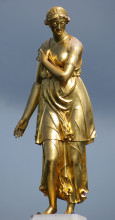
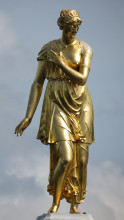
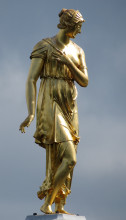
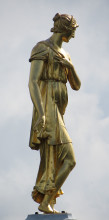
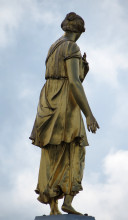
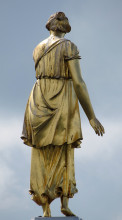
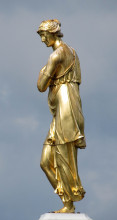
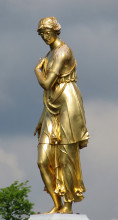
The lower figures consist of a mermaid and a boy, each repeated four times around the fountain. The mermaids are of the two tailed type (for discussion of such see this page), being a conventional female figure down to the waist, then with the two tails in place of the legs, curving round too early to indicate human legs down to the knee, each undertaking a spiral before emerging at the rear with an upturned fishy tailfin. They have some slight frilly fin effect at the upper thigh, if it can so be called, and scales becoming notable further down the tail. As with the Diana, the modelling of shoulders and arms is noticeable but a little understated; the hips wide, and the stomach rather more rounded than the ideal of later eras. Each mermaid cups her breasts in her hands, for the water was intended to flow from the breasts, something not unusual in Renaissance fountains but feeling a bit crude in concept today. They are seated on scaly fish, spiky around the head and toothy in the gaping mouths, from which water also flows.
The boys, or putti, are also Renaissance in feel, with some nobility of the face and a flowing of the locks of hair, and vigour to the movement of the figure. Each holds some fish, perhaps a sturgeon, by its tail and with the large head propped up on the elbow of the other arm.
Both mermaids and boys are based on figures from Giambologna’s Fountain of Mercury in Bologna, Italy, though in the detail they are very different, and Giambologna’s mermaids are seated upon dolphins, not fishes. In the Italian fountain, the boys are higher up than the mermaids, and the water from the fishes’ mouths falls into basins above the mermaids’ heads. The Diana Fountain was also originally set up with figures at different heights.
For a long time, on the basis of a brief mention by the diarist John Evelyn, Diana and the other statues were thought to be by the Florentine sculptor Francesco Fanelli, who worked as sculptor to Charles I from about 1632–43, but more recent attributions have given her, and the attendant figures, to Hubert le Sueur, known for his statue of Charles I in Trafalgar Square (and see this page for several pictures of this equestrian statue). Le Sueur also worked for Charles I, from 1626 or thereabouts through to 1641. Certainly the look of the eyes and the style of the figures of the Diana and the attendant figures (see picture above) is similar to that in Le Sueur’s various proven statues, and not particularly akin to the little bronzes of Fanelli.
Le Sueur is documented as making two fountains for Charles I, one with a figure of Mercury, the other with four shells, four sea monsters, and four boys with dolphins, together with ‘ye great statue on ye fountaine’, but with no record of who it was. He did however make at least two Diana statues for King Charles, including a ‘Great Diana’ by 1637, which has been suggested by Charles Avery, who wrote the most cogent discussion of Le Sueur’s works for the Walpole Society, to be perhaps the statue in the Hampton fountain. The Park authorities have suggested that the figure is of Arethusa, one of the Nereids, who herself was transformed by Artemis (i.e. Diana to the Romans) into a fountain. Their attribution is based on a Parliamentary inventory of the mid-17th Century. However, the problem is that while the fountain is believed to be a reconstruction of one at Somerset House, and later at Hampton Court Palace, whether the figures stayed the same or came from one or other of the two Le Sueur fountains has not been confirmed. Nor do we know on what basis the compiler of the Parliamentary inventory thought the statue was an Arethusa and not a Diana. We cannot therefore say if the crowning figure we see today was intended as a representation of Diana or Arethusa.
Looking at the figure, for a Diana we would normally expect a bow and arrows, and typically a hunting dog too (Diana the Huntress), but the Hampton figure has neither. However, her hand is clasping at her shoulder, so conceivably this could be Diana Wounded, another popular representation of the Goddess. In the end, without accoutrements, it seems fruitless to look to establish definitively if she is Diana or Arethusa, but the argument made by Avery and others that Diana would have been a more likely and appropriate figure for the King’s fountain seems reasonable, and given that for over 300 years it has been known as the Diana fountain, it would seem fair to keep the figure as Diana unless some rather more compelling evidence comes to light of an alternative.
For a couple of much more recent sculptural representations of Diana, see this page and this page.
We should mention the other decoration on the Diana Fountain. The figures have been rearranged at least once from their original positions, with the fountain being set up according to Christopher Wren's plans for Bushy Park, and the original stonework of the fountain does not survive. Rather, what we have is late 17th Century work - later than le Sueur was in England - by the sculptor Edward Pearce, who carried out considerable decorative sculptural work at Hampton Court and Whitehall. Some of this stone carving is illustrated in the view of the Diana Fountain below (you will need to click to enlarge). The great marble basin in which the fountain sits, dating from the Wren landscaping, has been identified by Gunnis, the sculptural historian, as the work of the carver and mason John Smout.
This page was originally part of a 'sculpture of the month' series, for May 2014. Although the older pages in that series have been absorbed within the site, if you would wish to follow the original monthly series, then jump to the next month (June 2014) or the previous month (April 2014). To continue, go to the bottom of each page where a paragraph like this one allows you to continue to follow the monthly links.
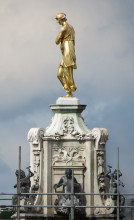 View of Diana Fountain showing carving by Edward Pearce.
View of Diana Fountain showing carving by Edward Pearce.
Nearby: monuments in Hampton Church and Teddington Church
Visits to this page from 1 May 2014: 9,286